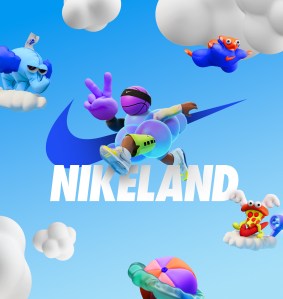
READ MORE: On the metaverse, look back to get ahead of the future (The Drum)
The metaverse will take years, if not decades, to fulfill its interconnected three-dimensional Web3 powered vision, but brands are encouraged to make the leap now.
If they don’t, they’ll be missing the chance to connect with audiences already playing in metaverse-like worlds.
The catch is: the rules of the game governing brand-audience relationships are different.
M&C Saatchi London’s Niall Wilson, writing an op-ed for The Drum, points out that the most popular virtual world mass-participant experiences online today are games — Roblox, Call of Duty, and Among Us being some of the biggest. Yet game-playing communities aren’t drawn from familiar “advertising” demographics.
“Age, gender, location, ethnicity and affluence aren’t the foundations on which these communities are built. I’m just as likely to be killed by my daughter in Fortnite as I am to bump into my uncle in Minecraft. I’m pretty sure they’ve met each other in Animal Crossing,” Wilson says.
YOUR ROADMAP TO Web3:
Does web3 offer the promise of a truly decentralized internet, or is it just another way for Big Tech to maintain its stranglehold on our personal data? Hand-picked from the NAB Amplify archives, here are the expert insights you need to understand web3’s potential and stay ahead of the curve on the information superhighway:
- Magnificent Obsession: Why Are We in Love With Web3?
- Web3 and the Battle For the Soul of the Internet
- Web 2.5 Is Just… Awkward
- Avatar to Web3: An A-Z Compendium of the Metaverse
- Brave New World? Sure, Just Click Here
What online games do is bring together diverse communities that share a passion for very specific experiences. Wilson suggests that those who like to be rebellious play Doom. People who like to compete: FIFA. Thrill seekers play The Last of Us and adventurers play World of Warcraft.
“The people who make mass multiplayer games are better at tapping into human passions and emotions than any other creators on earth. And brands familiar with connecting people and their passions find the world of gaming easier to penetrate,” Wilson writes.

Sports brands might find it easier than others to activate in the gaming virtual world. For example, Nike’s Nikeland experience in Roblox has been visited by more than 7 million people since it launched last November.
Other brands on the books of M&C Saatchi London, like O2, McDonald’s, Heineken and Coca-Cola, are making the transition to Web3 by continuing to connect communities to their passions, in much the same way that they have done before. Just virtually.
NAVIGATING THE METAVERSE:
The metaverse may be a wild frontier, but here at NAB Amplify we’ve got you covered! Hand-selected from our archives, here are some of the essential insights you’ll need to expand your knowledge base and confidently explore the new horizons ahead:
- What Is the Metaverse and Why Should You Care?
- Avatar to Web3: An A-Z Compendium of the Metaverse
- The Metaverse is Coming To Get You. Is That a Bad Thing?
- Don’t Expect the Metaverse to Happen Overnight
- A Framework for the Metaverse from Hardware to Hollywood and Everything in Between
“The brands that may struggle, however, are those that have grown quickly through the precision audience targeting of the social web,” says Wilson.
He advises these brands to find games with playing communities that share their values. Then they should start helping these communities to grow by enhancing (not interrupting) their gaming experience.
“Charities such as Calm and The Kiyan Prince Foundation have paved the way, showing us that gaming communities can be much more altruistic than the echo chamber of social media,” notes Wilson. “Any brand unable to clearly articulate its values will fall even further behind than they are now.”

Anyone looking for immediate success in the metaverse will however be disappointed. Especially if success is measured against conventional indicators like reach, awareness, and attention.
“[These] may simply not provide the ROI that many marketers crave,” says Wilson.
Instead, brands should experiment in the space and invest to learn what works and what does not.
“Those willing to invest now will have a better opportunity to build trust and advocacy over a longer period with some of the most passionate, engaged and diverse communities on earth,” Wilson urges. Who wouldn’t want to do that?

